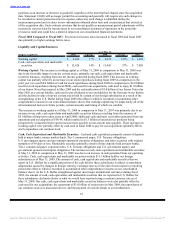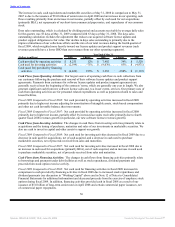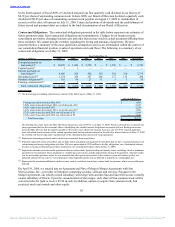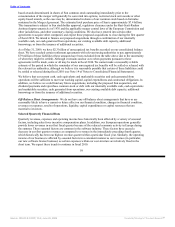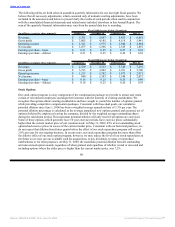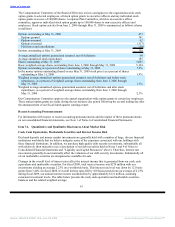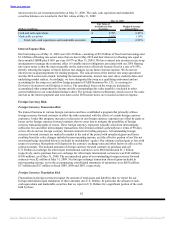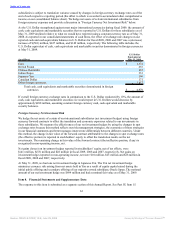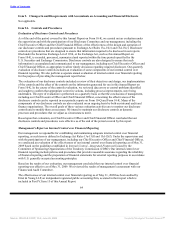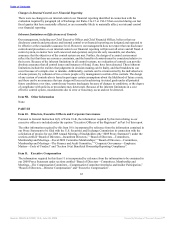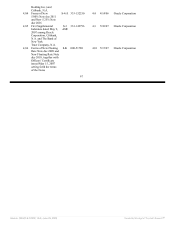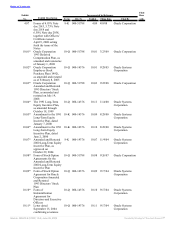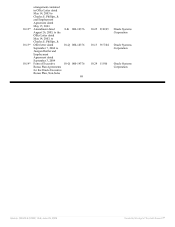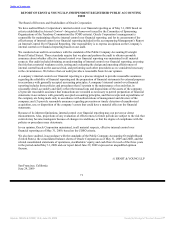Oracle 2008 Annual Report Download - page 70
Download and view the complete annual report
Please find page 70 of the 2008 Oracle annual report below. You can navigate through the pages in the report by either clicking on the pages listed below, or by using the keyword search tool below to find specific information within the annual report.
Table of Contents
Changes in Internal Control over Financial Reporting
There were no changes in our internal control over financial reporting identified in connection with the
evaluation required by paragraph (d) of Exchange Act Rules 13a-15 or 15d-15 that occurred during our last
fiscal quarter that have materially affected, or are reasonably likely to materially affect, our internal control
over financial reporting.
Inherent Limitations on Effectiveness of Controls
Our management, including our Chief Executive Officer and Chief Financial Officer, believes that our
disclosure controls and procedures and internal control over financial reporting are designed and operated to
be effective at the reasonable assurance level. However, our management does not expect that our disclosure
controls and procedures or our internal control over financial reporting will prevent all errors and all fraud. A
control system, no matter how well conceived and operated, can provide only reasonable, not absolute,
assurance that the objectives of the control system are met. Further, the design of a control system must
reflect the fact that there are resource constraints, and the benefits of controls must be considered relative to
their costs. Because of the inherent limitations in all control systems, no evaluation of controls can provide
absolute assurance that all control issues and instances of fraud, if any, have been detected. These inherent
limitations include the realities that judgments in decision making can be faulty, and that breakdowns can
occur because of a simple error or mistake. Additionally, controls can be circumvented by the individual acts
of some persons, by collusion of two or more people or by management override of the controls. The design
of any system of controls also is based in part upon certain assumptions about the likelihood of future events,
and there can be no assurance that any design will succeed in achieving its stated goals under all potential
future conditions; over time, controls may become inadequate because of changes in conditions, or the degree
of compliance with policies or procedures may deteriorate. Because of the inherent limitations in a cost
effective control system, misstatements due to error or fraud may occur and not be detected.
Item 9B. Other Information
None.
PART III
Item 10. Directors, Executive Officers and Corporate Governance
Pursuant to General Instruction G(3) of Form 10-K, the information required by this item relating to our
executive officers is included under the caption “Executive Officers of the Registrant” in Part I of this report.
The other information required by this Item 10 is incorporated by reference from the information contained in
our Proxy Statement to be filed with the U.S. Securities and Exchange Commission in connection with the
solicitation of proxies for our 2009 Annual Meeting of Stockholders (the “2009 Proxy Statement”) under the
sections entitled “Board of Directors—Incumbent Directors,” “Board of Directors—Committees,
Membership and Meetings—Fiscal 2009 Committee Memberships,” “Board of Directors—Committees,
Membership and Meetings—The Finance and Audit Committee,” “Corporate Governance—Employee
Matters—Code of Conduct” and “Section 16(a) Beneficial Ownership Reporting Compliance”.
Item 11. Executive Compensation
The information required by this Item 11 is incorporated by reference from the information to be contained in
our 2009 Proxy Statement under sections entitled “Board of Directors—Committees, Membership and
Meetings—The Compensation Committee—Compensation Committee Interlocks and Insider Participation,”
“Board of Directors—Director Compensation” and “Executive Compensation”.
65
Source: ORACLE CORP, 10-K, June 29, 2009 Powered by Morningstar® Document Research℠


